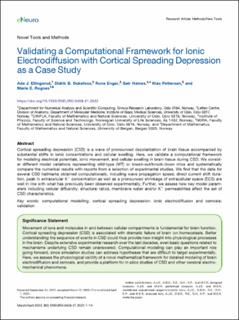| dc.contributor.author | Ellingsrud, Ada Johanne | |
| dc.contributor.author | Dukefoss, Didrik Bakke | |
| dc.contributor.author | Enger, Rune | |
| dc.contributor.author | Halnes, Geir | |
| dc.contributor.author | Pettersen, Klas Henning | |
| dc.contributor.author | Rognes, Marie Elisabeth | |
| dc.date.accessioned | 2023-01-20T14:36:15Z | |
| dc.date.available | 2023-01-20T14:36:15Z | |
| dc.date.created | 2022-10-19T07:58:25Z | |
| dc.date.issued | 2022 | |
| dc.identifier.issn | 2373-2822 | |
| dc.identifier.uri | https://hdl.handle.net/11250/3045022 | |
| dc.description.abstract | Cortical spreading depression (CSD) is a wave of pronounced depolarization of brain tissue accompanied by substantial shifts in ionic concentrations and cellular swelling. Here, we validate a computational framework for modeling electrical potentials, ionic movement, and cellular swelling in brain tissue during CSD. We consider different model variations representing wild-type (WT) or knock-out/knock-down mice and systematically compare the numerical results with reports from a selection of experimental studies. We find that the data for several CSD hallmarks obtained computationally, including wave propagation speed, direct current shift duration, peak in extracellular K+ concentration as well as a pronounced shrinkage of extracellular space (ECS) are well in line with what has previously been observed experimentally. Further, we assess how key model parameters including cellular diffusivity, structural ratios, membrane water and/or K+ permeabilities affect the set of CSD characteristics. | en_US |
| dc.language.iso | eng | en_US |
| dc.publisher | Society for Neuroscience | en_US |
| dc.rights | Navngivelse 4.0 Internasjonal | * |
| dc.rights.uri | http://creativecommons.org/licenses/by/4.0/deed.no | * |
| dc.title | Validating a Computational Framework for Ionic Electrodiffusion with Cortical Spreading Depression as a Case Study | en_US |
| dc.type | Journal article | en_US |
| dc.type | Peer reviewed | en_US |
| dc.description.version | publishedVersion | en_US |
| dc.rights.holder | Copyright 2022 the authors | en_US |
| dc.source.articlenumber | ENEURO.0408-21.2022 | en_US |
| cristin.ispublished | true | |
| cristin.fulltext | original | |
| cristin.qualitycode | 1 | |
| dc.identifier.doi | 10.1523/ENEURO.0408-21.2022 | |
| dc.identifier.cristin | 2062561 | |
| dc.source.journal | eNeuro | en_US |
| dc.identifier.citation | eNeuro. 2022, 9 (2), ENEURO.0408-21.2022. | en_US |
| dc.source.volume | 9 | en_US |
| dc.source.issue | 2 | en_US |

